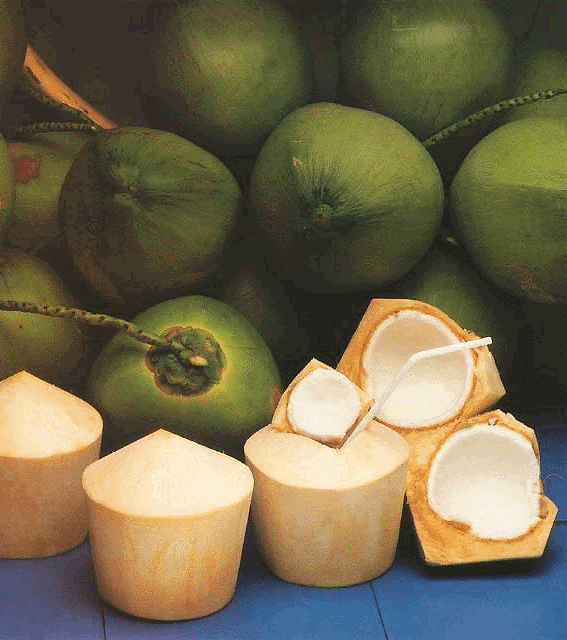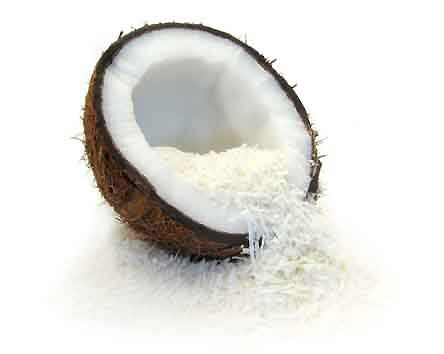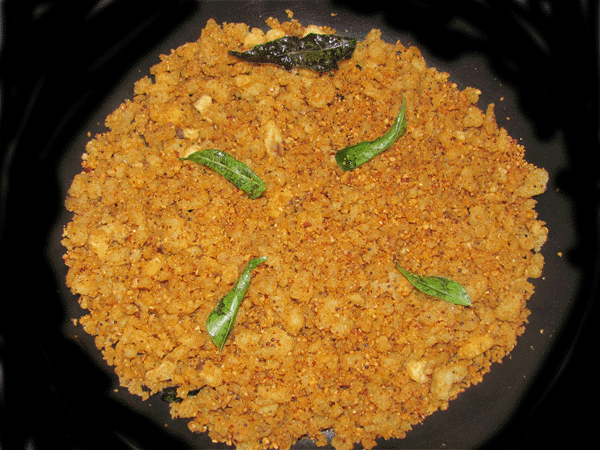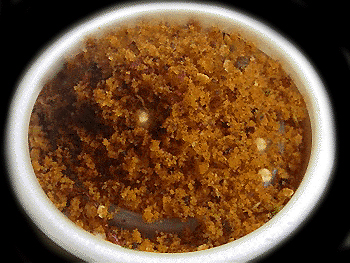
|
|
|
|
BY: SUN STAFF
 Jul 27, 2010 — CANADA (SUN) — A journey through India: border to border, bhoga to prasadam. Today we begin a new segment on one of the most fundamental of all ingredients used in Vedic cooking – the Coconut. Although coconuts mature into a familiar dark-brown, hard orb that resembles a large nut, it is actually the fruit of the Coconut Palm, a tree in the Arecaceae family. While no one is absolutely certain, most consider the origin of Coconut Palms to be Southeast Asia, somewhere in the vicinity of India and Malaysia. Today, Kerala in South India is the undisputed Coconut capital of the world, where the long, beautiful beaches lines with Coconut Palms are second only to the rich foodstuff s cooked from the fruit.
Much like bananas or mangoes, coconuts have such a diverse history in ancient Vedic culture and such a tremendously wide range of uses in cooking that it's difficult to know where to begin, and impossible to cover the gamut of coconut's uses in just three short articles. We find many sastric references to the coconut, which is mentioned throughout Sri Caitanya-caritamrta, primarily by one of its Sanskrit names -- narikela. It is known by many other names across India – in fact, there's a word for coconut in at least 74 different languages. When it comes to searching for first-class prasadam recipes that use coconut, some of the choice names to look for are nariyal/nariyel (Hindi, Gujarati, Urdu); kobbari (Kannada); nargil (Farsi); gari (Hindi); khoprah (Kashmiri), ilaneeru, karikku, naligeram or thengu (Malayam); nadiya (Oriyan); tengai, tengu or tennai (Tamil); and kobbarikaya, narikelamu or tenkaya (Teluga). And these are just the basic names for coconut! There is a long list of terms for the many types of coconut products, like dessicated coconut (sukha nariyal), coconut milk (nariyal ka doodh), coconut sugar (gula melaka), or coconut treacle (kithul). In Caitanya-caritamrta we will read passages that describe narikela-sasya (coconut pulp), mista narikela (sweet coconut); narikela-jala (coconut water), and narikela-sasya (green coconut pulp). There are also beautiful prasadam preparations like narikela-khanda nadu (sweetmeat balls made with coconut powder), mukuta-narikela (a hard coconut sweet), and narikela-puli, a cake made from coconut. There are many functional categories of cooking that feature coconut. Coconut milk, cream, and pastes are used as a sabji base, and all are equally adaptable to dals. Both fresh and dry flakes are a premium ingredient in sweets and all sorts of baked goods. Powders are made from coconut flesh, either raw to toasted, and these can be used in every imaginable way. And like banana leaves, coconut shells are highly utilitarian as serving bowls and the like. There are four primary products offered by the coconut for our use in cooking: the copra, water, milk/cream, and oil. Copra is the white coconut meat that makes up the bulk of the fruit. It can be eaten fresh, either raw or cooked, or it can be dried and flaked. The flakes can be further toasted, stewed or steamed for a range of nice tastes and textures. Dry flake coconut is very nice when ground into a podi (powder), or rubbed into a paste. Inside the coconut shell is found a wonderful drink, known as coconut water or juice. Both the young green coconuts and the mature, brown fruits have this liquid at the center, although only the young fruit juice is palatable. Those new to cooking with whole coconuts are sometimes surprised to find the clear liquid at the center, thinking they will instead find a thick, creamy coconut milk. In fact, the milk is produced by processing the grated coconut flesh with hot water or milk. This helps to extract the oil and all the aromatic flavor components from the fruit, which together are blended into the rich coconut milk and cream. Once you prepare the coconut milk, simply sit it in the refrigerator overnight to let the rich coconut cream rise to the top, just as cow's milk produces cream. This thick, sweet cream is fabulous stuff, used fresh or cooked in preparations. Both the milk and cream are high in fat content (about 17%).

Coconut also products an excellent oil, which is usually extracted back out of the milk, and this oil is also high in saturated fat. It's very healthful stuff when taken in proper quantities. Pure virgin coconut oil is highly prized, as you'll see by its price. It's wonderful to use in low-heat frying, cooking, baking, and even rubbing directly onto the skin as a moisturizer and conditioner. Those traveling to India are often cautioned about drinking the contaminated water, which regularly results in stomach upset, diarrhea, and dysentery. Commercial bottled water sold on the streets isn't much better than tap water, so devotees often resort to getting their liquids from coconut whenever possible. Even HH Jayadvaita Swami offers this advice on his India Health Tips webpage, where he writes: "Drink water from reliable sources: taps and pumps approved by the local educated people, or bottled water. Always safe: water straight from a fresh green coconut." Fresh coconut water is known to be very nutritious, containing sugars, Vitamin E, amino acids, minerals, and antioxidants. It can be consumed straight from the fruit, or added to other beverages. Only the water from fresh green coconuts is good for drinking, and the very young fruits will not yet have produced any liquid. As the fruit beings to ripen, the water becomes slightly fizzy, and by the time the husk has turned brown, the liquid has soured. Once a fresh young fruit has been cracked open and the liquid enjoyed, there is another wonderful product to be had inside the shell, known as 'spoon meat'. This is a soft, sweet, gelatinous portion of coconut flesh just rimming the center cavity. This delicacy is often spooned out and eaten with hot chilis – a combination that cools the tongue while heating the body, which helps one to feel cooler in the hot weather.

In Ayurvedic texts, coconut liquid is recommended to heat the body, and some Vedic texts state that the water will act as an aphrodisiac. Over the ages, coconut liquid has been used as an intoxicant, sometimes steeped like a wine. In the Agni Purana, coconut sap is classified along with wines made from grapes, sugarcane, and palm. So while the fresh water of coconuts may be a good alternative to contaminated water, it should be consumed in moderation, and never taken when fermented. The sugars alone will tend to stimulate the senses. One of the most basic, yet most palatable of all coconut dishes is Coconut Rice. It can be made as simply as by adding coconut powder to the rice's cooking water, or cooking the rice in coconut milk. The following recipe offers a more complex set of flavors, highlighting the fresh, wonderful taste and aroma of coconut.


Bese Bele Among our favorite ways to use coconut is in dry, ground podis or pulses. Following are two excellent recipes that can be prepared and stored, for day-to-day use. The powders let you add a tremendous amount of flavor to dishes that are quick-cooked, but end of tasting like you spent hours preparing them. Ingredients: Dry roast each of the dals separately, toasting until they've darkened a few shades (10 to 15 minutes). Set aside to cool. Add to the pan the cumin, coriander, fenugreek, cinnamon, cloves, chilis, and dry roast for about 10 minutes, until darkened several shades. Add the curry leaves and coconut and continue dry roasting for another 5 minutes. Remove from the heat, cool, and mix with the dal. Grind the mixture to a fine powder, and store in an airtight container in a cool place, for up to three months, using as needed in sabjis, dals, rice dishes, etc.

Hagalakayi Kobbari Pudi
| |